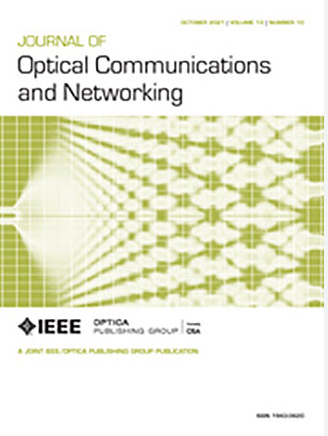流量感知和物理约束光网络增长技术
IF 4.3
2区 计算机科学
Q1 COMPUTER SCIENCE, HARDWARE & ARCHITECTURE
引用次数: 0
摘要
对于面临流量快速增长的运营商来说,最大化网络吞吐量至关重要。实现这一目标的一个有效策略是通过有针对性的网络扩展——战略性地增加边缘以最大限度地提高网络吞吐量,不仅针对特定的需求集,而且针对未来的流量增长。寻找新边的最优组合以最大化吞吐量是一个NP-hard优化问题。因此,在这项工作中,我们提出了四种可扩展的网络扩展方法,这些方法考虑了网络流量分布和网络的物理和结构特性,以选择要添加到光基础设施中的边缘。所提出的方法要么属于割集范畴,要么属于割集和消息传递组合(混合)范畴。切集方法的目的是增加新的边缘,消除网络中的结构性瓶颈,优先考虑那些减少路径长度或增加信噪比(SNR)的边缘。混合方法利用消息传递和切集方法的优势,通过战略性地选择新的边缘来减少通过消息传递的路径长度,同时使用切集技术瞄准瓶颈。我们将这些方法应用于100个基于nfsnet的合成图和44个现实世界的拓扑,并根据文献中先前评估的两种基线方法评估了它们的性能。数值结果表明,所提方法优于基线方法。考虑信噪比的方法比考虑路径长度的方法性能更好,拓扑特性对所提出的网络扩展方法的性能有显著影响。本文章由计算机程序翻译,如有差异,请以英文原文为准。
Traffic-aware and physically constrained optical network growth techniques
Maximizing network throughput is crucial for operators facing rapid traffic growth. One effective strategy for achieving this is through targeted network expansion—strategically adding edges to maximize network throughput, not only for a specific set of demands but also for future traffic growth. Finding the optimal combination of new edges to maximize throughput is an NP-hard optimization problem. Therefore, in this work, we propose four scalable network expansion methods that consider the network traffic distribution and the network’s physical and structural properties to select the edges to be added to the optical infrastructure. The proposed methods belong to either the cut set category or the cut set and message-passing combinations (hybrid) category. The cut set methods aim to add new edges that eliminate structural bottlenecks in the network, prioritizing either those that decrease path length or increase signal-to-noise ratio (SNR). The hybrid methods leverage the strengths of both message-passing and cut set approaches by strategically selecting new edges to reduce path lengths through message passing while targeting bottlenecks with the cut set technique. We applied these methods to 100 NFSNet-based synthetic graphs and 44 real-world topologies and evaluated their performance against two baseline methods previously evaluated in the literature. Numerical results show that the proposed methods outperform the baseline approaches. Methods taking the SNR into account perform better than those considering path lengths, and topology properties significantly impact the performance of the proposed network expansion methods.
求助全文
通过发布文献求助,成功后即可免费获取论文全文。
去求助
来源期刊
CiteScore
9.40
自引率
16.00%
发文量
104
审稿时长
4 months
期刊介绍:
The scope of the Journal includes advances in the state-of-the-art of optical networking science, technology, and engineering. Both theoretical contributions (including new techniques, concepts, analyses, and economic studies) and practical contributions (including optical networking experiments, prototypes, and new applications) are encouraged. Subareas of interest include the architecture and design of optical networks, optical network survivability and security, software-defined optical networking, elastic optical networks, data and control plane advances, network management related innovation, and optical access networks. Enabling technologies and their applications are suitable topics only if the results are shown to directly impact optical networking beyond simple point-to-point networks.

 求助内容:
求助内容: 应助结果提醒方式:
应助结果提醒方式:


